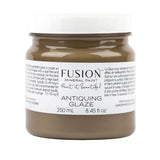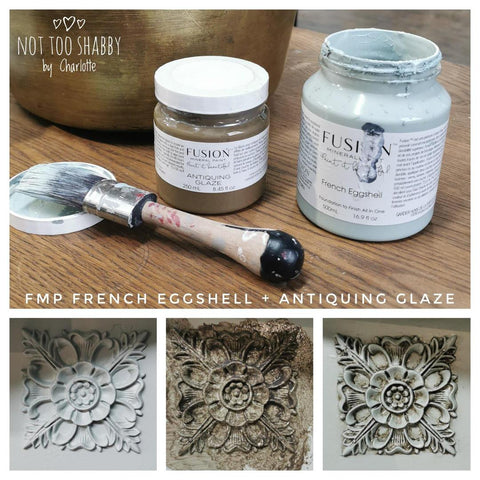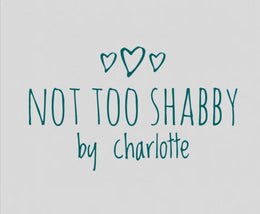So why do I love glaze?
If you look at antique furniture you'll see that most of it isn't one flat colour. It's normally waxed or varnished and where the product collects in the corners and the mouldings you get darker shades.
Glaze helps you to replicate this beautifully and in any new colour you choose!
Glaze has this gorgeous translucent quality which allows the layer beneath to shine through and accentuates it. It adds depth which is so interesting and authentic. On some pieces of furniture a flat paint finish is perfect, those pieces with clean lines and flat panels... mid century modern pieces are a perfect example of this. Other pieces look dull and flat with a one colour finish, paint is the perfect base coat but they need a little more.
Glaze takes your piece from nice...to incredible!

Live Glaze Tutorial
This month's tutorial over in our Fusionistas Nottingham Facebook group was all about glaze, head over to the group to watch it on replay. Just select the 'tutorials' topic at the top of the group and you'll find all our past tutorials.



Examples Of Glazed Furniture




Left - This piece is a darker Taupe shade mixed from the recipes on the Fusion Fan Deck with a lighter Taupe shade blended into the centre of the panels. Antiquing Glaze has been applied to give it an aged industrial look
Right - Here an Ash glaze has been applied over Lamp White, the piece has then been lightly sanded back to remove the glaze from the high points and reveal tiny peaks of the wood beneath
What's The Process For Glazing Furniture?
Firstly you take the Clear Glaze and mix in a tiny bit of paint to colour it. You only need a small amount, it shouldn't thicken the glaze much just add colour.
Once it's evenly mixed apply it over your piece of furniture. Work in sections and ensure you get the glaze into all of the details of the mouldings and the grain as these are the areas which would be a deeper shade on furniture, they are the shadows and are in the background.
Glaze has a longer open time than paint, this means it will take longer to dry and that you will have much longer to manipulate it to get the effect that you're after.
Now you can wipe away the excess. Use a rag and wipe away the glaze from the raised areas until you get the desired effect. This will leave the glaze in all those recesses and you'll notice those beautiful details have now come to life!
You can wipe gently to leave a little glaze behind and tint your entire piece.
You can wipe harder to remove more glaze and just leave it in the deep crevices.
You can use a damp rag or a spray mister to remove completely from the raised areas, if your don't want to contaminate your flat panels at all.

How To Use Glaze To Create Texture
The techniques that you choose to wipe off your excess glaze will affect the texture that is left behind.
If you wipe in the direction of the grain you can create a linear effect that mimics and accentuates the grain.
If you screw up your rag and dab the glaze off you can create a mottled texture like I did on this lamp shade. This was create by applying a Renfrew Blue glaze over Brook.

You can create all sorts of different textures by using different applicators and different wiping methods. This is the fun of painting, you can let your creativity go wild!
Using Metallic Glazes
You can create metallic glazes by mixing any of our Fusion Metallics with the Clear Glaze. This is great for creating a sheen over your furniture or for replicating metal like I have done on this lamp base.
This lamp base has been painted in Algonquin, then I experimented by layering a chocolate glaze, then a champagne glaze, then a bronze glaze


Layering Glazes
The wonderful Jennylynn, creator of Fusion Mineral Paint has done an awesome tutorial on layering Glazes of you fancy seeing more. Doesn't that door have the most incredible colours and textures!

I'm sure you're ready to get glazing...be warned its mega satisfying and addictive!
Happy painting guys xxx

Can you use a metallic glaze over an IOD paint inlay? If so, do you glaze before you add the inlay? Or, do you apply the inlay, seal and then apply the glaze. Thanks so much, Christine
👋 These guys have very awesome products. Keep sharing unique products and information with us. 🤩
I also recommend it for those who are looking to upgrade their bedroom. 👍 Make your bedroom a place to relax with also https://beautifulbeds.co.uk/
Leave a comment